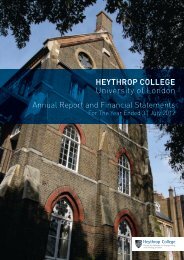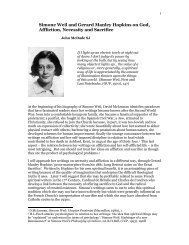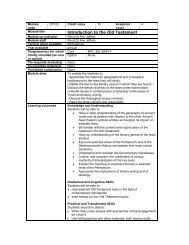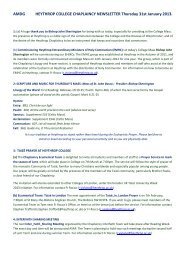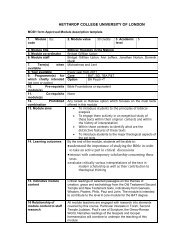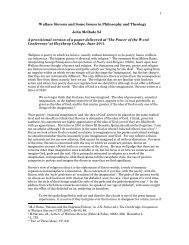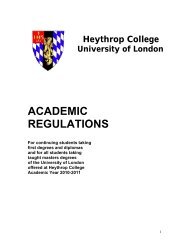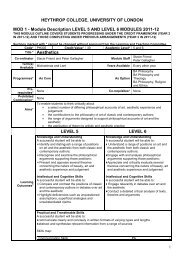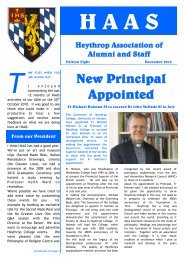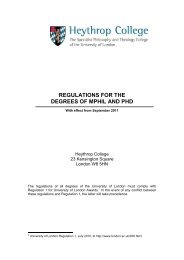Von Balthasar and the Office of Peter in the Church
Von Balthasar and the Office of Peter in the Church
Von Balthasar and the Office of Peter in the Church
You also want an ePaper? Increase the reach of your titles
YUMPU automatically turns print PDFs into web optimized ePapers that Google loves.
sa<strong>in</strong>ts <strong>of</strong> <strong>the</strong> <strong>Church</strong> who always „represent <strong>the</strong> l<strong>in</strong>k between <strong>the</strong> Marian<br />
<strong>and</strong> <strong>the</strong> Petr<strong>in</strong>e <strong>Church</strong>‟ (225). <strong>Balthasar</strong> sees Johann<strong>in</strong>e love as fulfill<strong>in</strong>g a<br />
mediat<strong>in</strong>g role, first <strong>of</strong> all, between Christ <strong>and</strong> <strong>Peter</strong>‟s pastoral <strong>of</strong>fice: when<br />
<strong>Peter</strong> is asked by Christ, „Do you love me‟ he is asked to share <strong>in</strong><br />
Johann<strong>in</strong>e love as a condition <strong>of</strong> his exercis<strong>in</strong>g <strong>the</strong> pastoral m<strong>in</strong>istry („Feed<br />
my sheep‟). <strong>Peter</strong> is rem<strong>in</strong>ded by Christ that Johann<strong>in</strong>e love will rema<strong>in</strong><br />
(<strong>in</strong> <strong>the</strong> <strong>Church</strong>) until Christ returns <strong>in</strong> glory: „In <strong>the</strong> unfathomable mystery<br />
<strong>of</strong> Jesus‟ good pleasure, John reta<strong>in</strong>s his own mission, dist<strong>in</strong>ct from that <strong>of</strong><br />
<strong>Peter</strong>‟. John 21 conta<strong>in</strong>s „a subtly composed symbolic doctr<strong>in</strong>e <strong>of</strong> <strong>the</strong><br />
<strong>Church</strong> <strong>in</strong> which <strong>the</strong> task <strong>of</strong> “<strong>of</strong>fice” (<strong>Peter</strong>) <strong>and</strong> <strong>the</strong> task <strong>of</strong> “love” (John)<br />
become...<strong>in</strong>tertw<strong>in</strong>ed‟ (142). John‟s second mediat<strong>in</strong>g role, between <strong>the</strong><br />
(lay) Marian <strong>and</strong> <strong>the</strong> (<strong>in</strong>stitutional) Petr<strong>in</strong>e <strong>Church</strong> is signalled by his<br />
faithful discipleship at <strong>the</strong> foot <strong>of</strong> <strong>the</strong> Cross when, <strong>Peter</strong> hav<strong>in</strong>g denied<br />
Christ, John becomes <strong>the</strong> son <strong>and</strong> guardian <strong>of</strong> Maria-Ecclesia. „The truly<br />
Johann<strong>in</strong>e <strong>Church</strong> is... <strong>the</strong> one that st<strong>and</strong>s under <strong>the</strong> Cross <strong>in</strong> place <strong>of</strong> <strong>Peter</strong><br />
<strong>and</strong> on his behalf receives <strong>the</strong> Marian <strong>Church</strong>‟ (225).<br />
James, <strong>the</strong> bro<strong>the</strong>r <strong>of</strong> <strong>the</strong> Lord, represents <strong>the</strong> dimension <strong>of</strong> tradition <strong>and</strong><br />
law (Torah). The leader <strong>of</strong> <strong>the</strong> Jewish-Christian Jerusalem community<br />
(<strong>the</strong> ecclesia ex circumcisione) -- tak<strong>in</strong>g <strong>Peter</strong>‟s place after he leaves<br />
Jerusalem (Acts 12.17) -- he represents cont<strong>in</strong>uity between <strong>the</strong> Old <strong>and</strong><br />
New Covenants <strong>and</strong> <strong>the</strong> dimension <strong>of</strong> Torah-observance that Jesus came to<br />
perfect. James mediated between Jews <strong>and</strong> Gentiles at <strong>the</strong> first Council <strong>of</strong><br />
Jerusalem, reconcil<strong>in</strong>g conservative Jewish Christians to <strong>the</strong> presence <strong>in</strong><br />
<strong>the</strong> <strong>Church</strong> <strong>of</strong> „those not under <strong>the</strong> law‟ (1 Cor 2.20-1). He puts forward<br />
noth<strong>in</strong>g less than „<strong>the</strong> perfect law <strong>of</strong> liberty‟ (James 1.25). The Jewish<br />
writer Franz Rosenzweig <strong>in</strong> <strong>the</strong> early part <strong>of</strong> this century suggested that<br />
God‟s „Star <strong>of</strong> Redemption‟ had Judaism at its core from which <strong>the</strong> rays <strong>of</strong><br />
Christianity spread to <strong>the</strong> Gentile world; Rosenzweig argued that<br />
Christianity had to stay close to Jewish faith <strong>and</strong> observance or it would get<br />
lost <strong>in</strong> <strong>the</strong> gnosticisms <strong>of</strong> <strong>the</strong> pagan world. By mak<strong>in</strong>g <strong>the</strong> pr<strong>in</strong>ciple <strong>of</strong><br />
tradition <strong>and</strong> law constitutive <strong>of</strong> <strong>the</strong> <strong>Church</strong>, <strong>Balthasar</strong> echoes Rosenzweig<br />
<strong>in</strong> mak<strong>in</strong>g <strong>the</strong> tie to Jewish tradition a bulwark aga<strong>in</strong>st cultural<br />
assimilation <strong>and</strong> compromise.<br />
Paul represents <strong>the</strong> dimension <strong>of</strong> universalism <strong>and</strong> <strong>in</strong>culturation. The<br />
apostle <strong>of</strong> <strong>the</strong> ecclesia ex gentibus, he represents <strong>the</strong> <strong>Church</strong>‟s engagement<br />
with <strong>the</strong> cultures <strong>of</strong> <strong>the</strong> world, <strong>in</strong> which it is to f<strong>in</strong>d a home, becom<strong>in</strong>g „all<br />
th<strong>in</strong>gs to all people...for <strong>the</strong> sake <strong>of</strong> <strong>the</strong> Gospel‟ (1 Cor 9.22-3). He also<br />
represents charismatic vocation—he is outside <strong>the</strong> structure <strong>of</strong> <strong>the</strong> Twelve,<br />
yet is given a vocation which <strong>the</strong> hierarchical <strong>Church</strong> must acknowledge as<br />
willed by Christ—<strong>and</strong> dynamic mission modelled on <strong>the</strong> „type‟ <strong>of</strong> Christ<br />
(144). He also represents <strong>the</strong> dimension <strong>of</strong> <strong>the</strong> creation <strong>and</strong> development<br />
<strong>of</strong> local churches—his „anxiety for all <strong>the</strong> churches‟ (2 Cor 11.28) <strong>and</strong> his<br />
„travail till Christ be formed‟ <strong>in</strong> <strong>the</strong>m (Gal 4.19) -- which are to f<strong>in</strong>d <strong>the</strong>ir<br />
place with<strong>in</strong> <strong>the</strong> Catholica. He also symbolises <strong>the</strong> dimension <strong>of</strong> freedom<br />
<strong>in</strong> <strong>the</strong> Spirit: <strong>the</strong> dialectic between James <strong>and</strong> Paul (Rom 4.2-3 versus<br />
James 2.20-23) mirrors <strong>the</strong> dialectic <strong>in</strong> <strong>the</strong> <strong>Church</strong> between freedom from<br />
<strong>the</strong> Law <strong>and</strong> obedience to <strong>the</strong> Law until <strong>the</strong> return <strong>of</strong> Christ. He is, <strong>in</strong><br />
short, <strong>the</strong> dimension <strong>of</strong> apostolic energy <strong>in</strong> <strong>the</strong> <strong>Church</strong>.<br />
10



